Amanda Roberts's Blog, page 19
June 7, 2015
China Street Photography
Today’s guest post comes from David at Photography Dock. I am sure all expats want to take the best and most striking pictures of their travels abroad, so I was thrilled when David offered to do this guest post on taking street shots in China. I hope you will find it as educational as I did.
Having lived in China for more than 5 years now, I’ve decided to embark upon a journey of sharing what has most impressed me from this fascinating country. I’ll be covering the areas that I think matter most, and of course include illustrations and guidance to help you take good photos when you next spend time in China.
For part one of this journey, we will look at what has always been my favourite subject to photograph here – the people on the streets! China street photography is an incredibly rich and rewarding experience, mostly because of the sheer diversity of shots available. So let’s take a look at my 5 important areas to remember when shooting people in China, helping you to improve your own China street shots.
1. Capture the stark contrasts in generations
Perhaps the most interesting contrast to be found in China is the difference between the young and the old. It’s difficult to describe just how different the experience of life has been between these two generations. So much has changed in this country’s environment, and so much is still changing.
The first shot is taken at my favourite local spot, Da yan ta (大雁塔). Singing, breakdancing, and skating all regularly happen here side-by side. The picture reflects just how important the younger generation sees hobbies these days – and it’s all about bragging rights.
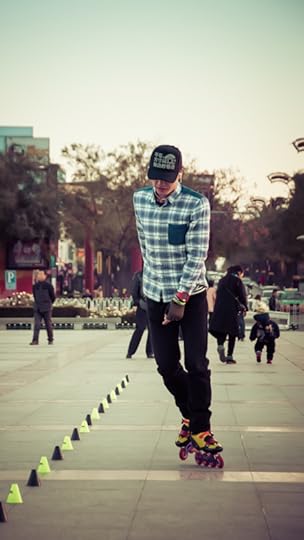
A young skater – 1/200, f5.6, ISO 800
I took the second shot another province across from mine in Lijiang, Yunnan. Another fantastic part of this culture is watching the older generation rise early, and meet together to sing and dance. You can see the first character just soaking up the ambient music, with the background figure throwing his arms around in joy whilst dancing to the music.
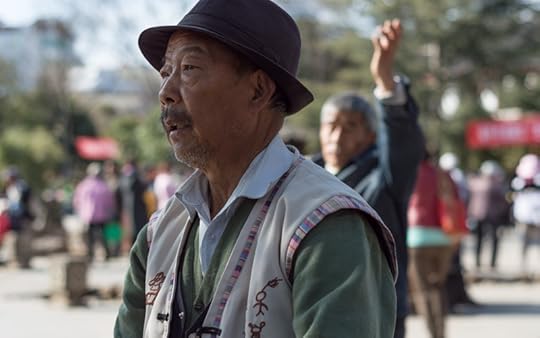
Early morning music and dance – 1/1000, f2.8, ISO 100
All of this action is easily caught by just researching the area in advance so you know where to go and for what optimal times to see the most interesting action.
2. Show the skills of the people
Another fascinating part of life here in China is that one minute you can be strolling down the street to pick up some vegetables, and the next you find yourself completely absorbed in watching some skilled individual at work on the roadside.
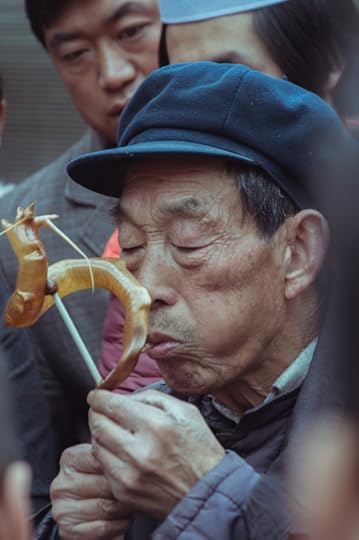
Another skilled worker – 1/60, f5.6, ISO 400
The above shot is from a famous food street on the south side of Xi’an. Every time I pass by, there is some kind of new and interesting food being made, often with some level of skill being applied to produce it.
The second shot shows another individual producing and displaying his best calligraphy skills for others to appreciate. Chinese in its written form is not just about communication, at its highest form it is considered an art.

The art of calligraphy – 1/160, f10, ISO 100
These types of shot are usually available within the commercial districts of each city. Often they are not registered shops, but just places that are run off of the back of some bike, or three-wheeler. So a bit of luck is also involved with finding them.
3. Display the wonderful ethnic diversity
“What is China like?” The longer I live here, the harder it becomes to answer that question. With 1.3 billion people, across numerous mega-cities, and provinces, and including over 50 vastly different minority groups, the only real answer I find myself able to give is ‘well…it’s very diverse!’
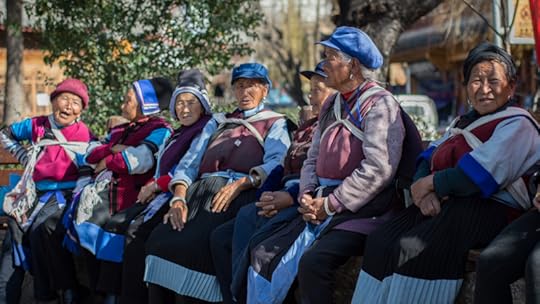
The Naxi people group – 1/800, f2.5, ISO 100
The previous shot is again from Yunnan showing some of the Naxi people sitting outside in their wonderfully vibrant clothing. Such fantastic colours makes for wonderful photography!
Be sure to look for what stands out, and visit areas that you know will feature a different culture within the culture. Just be very careful of tourist traps. Because in China when a place becomes well-known you can be certain it will very quickly become overcrowded and expensive. China’s huge population makes this a certainty.
4. Reflect both work & leisure
The massive advancement of China in recent years has meant that there have been many average Chinese people working their socks off to try and move this vast country forwards. I can think of few cultures where people work as hard as they do in China.

Hard at work in the midday sun – 1/800, f2.5, ISO 100
The first picture was taken in the Xi’an botanical gardens, but away from all of the beautiful flowers. After busily snapping many shots of flowers, I noticed how these two individuals were slaving away on a very hot summer’s day to begin planting new flowers. There are examples everywhere of people working hard, try to get close enough to even show those sweat beads!
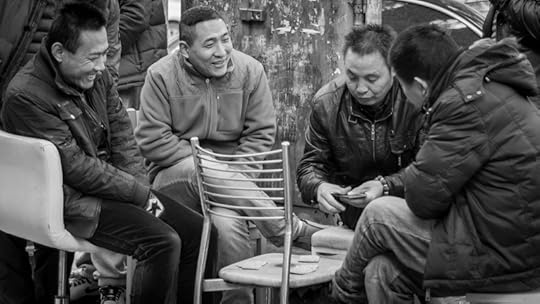
An impromptu game of cards – 1/100, f2.2, ISO 100
The second picture showed one of the many outdoor gatherings of men playing cards that can be seen across the city. The seemingly impromptu gathering for games of chess or cards always brings plenty of emotion to an often rather stoic faced people. Of course, emotion also makes for great photos! So also look out for leisure activities, especially earlier in the mornings in local parks.
5. Shoot both the old and the new
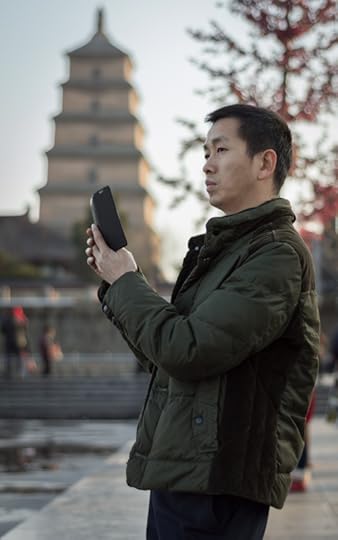
One more smartphone user – 1/640, f2.2, ISO 100
The other major contrast of life in China is between the old and the new. Technology races ahead, and new buildings soar into the sky on almost every street you go down. But yet those older traditions are quietly, but stubbornly refusing to disappear.
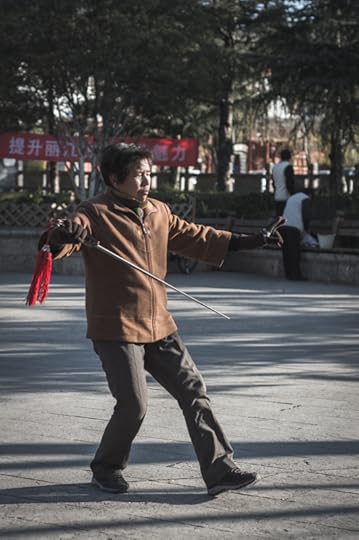
Some early morning swordplay – 1/1250, f2.8, ISO 200
Be sure to capture the borderline obsessive use of technology in this land, but also don’t forget to capture the Tai chi, various forms of swordplay, or the (my not so personal favourite) Chinese opera singing. Capturing a different culture on film is all about discovering exactly what is unique, and in China you don’t really have to look far to find that.
Bonus tip: Try switching to auto-ISO, and set the shutter speed to at least 1/100th for your shots
 during travelling. That way a change in environment will not result in blurred or under/over exposed photos.
during travelling. That way a change in environment will not result in blurred or under/over exposed photos.
 Dave Cossey is the writer and owner of the ‘photography dock’ blog. He can be found living and working in the ancient city of Xi’an, China alongside his wife where he has remained away from his home in the UK for the past 5+ years. He is an avid photographer, and his passion lies in enabling others to take their very own great photos.”
Dave Cossey is the writer and owner of the ‘photography dock’ blog. He can be found living and working in the ancient city of Xi’an, China alongside his wife where he has remained away from his home in the UK for the past 5+ years. He is an avid photographer, and his passion lies in enabling others to take their very own great photos.”
What about you? What are your tips for taking great photos while traveling? Feel free to share some of your best shots in the comments!
Would you like to write a guest post for Two Americans in China? Send us an email at TwoAmericansInChina@gmail.com.
May 31, 2015
The Big Con – Our Nightmare Saturday at the Guangzhou Comic Con *UPDATES at the end*
My husband Seth and I are big geeks, as everyone who knows us or has read this blog knows. We have gone to great lengths to recapture some of the geeky atmosphere we left behind in our old country. This has including visiting some pretty lame and poorly organized gaming and anime conventions around China. But while I have complained before about the heat, crowds, and lack of general fun that has accompanied conventions we have been to in the past, the Guangzhou Comic Con, sponsored by Wizard World and Coca-Cola, was by far the worst we have even been to.
We were initially really looking forward to this convention. An actual Comic Con? Organized by Wizard World? Sponsored by Coke? This is gonna be awesome! But, no.
The warning signs that this was going to be a terrible event started about a week before we went. The convention site was moved only a week before, but no messages were sent out in English to ticket buyers nor was the English version of the website ever updated with the new location. It seemed very strange to move such a large event so close to the date, but this is China and things like this happen all the time. Thankfully, we found out about the change and got the new address before we even left Shenzhen. Others, though, weren’t so lucky and didn’t find out until after they arrived at the original location.
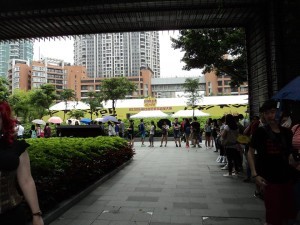
The tent where the con was held
The new location was literally a popup tent in the courtyard of a hotel. It was so small! At 10:00, the line was already wrapped all the way around the building and out to the street. 10:00 was when they were supposed to open the doors to let people in, but they didn’t. At this point, it was already more than 80 degrees outside and the lines were in the sun. Seth and I were in our full Steampunk attire and were already melting.
Stupidly, even though we had bought our tickets two weeks before and had a code on our phone, we were still required to go print them out, because having a scanner by the door would have been the smart and logical thing to do. But like all events in China, there were no signs directing you where in go, in Chinese or in English. Seth and our friend Paul had to ask half a dozen people and walk around the venue three times before accidentally stumbling on the kiosks where we were supposed to print our tickets.
Already hot and exhausted, we went to a Costa Coffee for cold drinks and some food. Then Seth headed back out and got in the tortuous line. By 11:00, they still were not letting people in the building. By 11:30 they had let some people in, but not enough to make much of a dent in the line. The popup tent quickly filled and they couldn’t let in any more people until the others left, but no one was leaving because many of them were hoping to catch a glimpse of the stars who were going to be there.
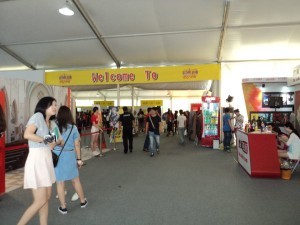
Inside the tent.
If you were one of the couple of hundred people “lucky” enough to get inside, it wasn’t worth the wait or the money. There was literally NOTHING inside the tent. There was a Coca-cola booth, a That’s PRD booth (a local magazine), a few standees you could take your pictures with, and a documentary playing about “the history of Comic Con.” Most of the tent was blocked off to make room for the queues to meet the celebrities who would be arriving between noon and 1:00 p.m.
By 12:00 the celebrities started arriving, and they were not happy with what they saw. Thousands of guests and fans were still standing outside in the broiling sun, and inside, it was so crowded there weren’t even any chairs for them to sit and sign autographs.
by 12:30, my friends who have two small children had had enough. They took their little children (about 2 and 4 years old, the smallest kids we saw there) to the organizers and demanded an explanation. As one of our friends was chewing out an organizer from Coca-cola (who was shocked we were still there after we had first yelled at him two hours before), her baby started two faint, so they let them go in the tent. That was how we found out there was nothing inside the tent so no reason to stay.

Real-life hero, Lee Pace
However, about this time, the gorgeous elf king Thranduil himself, Lee Pace, showed up and walked right past them. They snapped a quick picture of him before the crowd started to stampede and about crush their little boy. Pace reached out and shielded their son from the crowd so he wouldn’t be hurt. Lee Pace, real-life hero.
After that, we all had had about enough and decided to leave. We met up with some other friends who had just arrived and they said they would hag out and try to go to the con later if the crowds thinned out.
The crowds never did.
In fact, they got worse.
About 2:30, the organizers announced that no one else would be allowed inside (not that they had let anyone in since about noon) and only VIP ticket-holders would be allowed inside on Sunday. A mini riot broke out, which caused the celebrity guests to be evacuated the police to form a human barricade around the tent. The organizers then said they would issue refunds for all the regular ticket holders, but they didn’t give any directions about how to get the refund. We have contacted event organizers directly as well as Wizard World and Coke via their website, Facebook, and Twitter, all to no response, so we have not received any refunds.
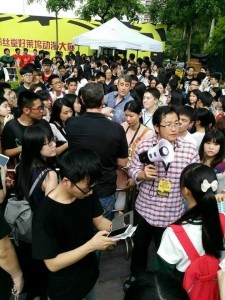
The mini riot that broke out and a Coke organizer trying to rein it in
As I said at the outset, we have been to some pretty crazy and disappointing conventions in China before, but this was hands down the worst. As my friend said, “this wasn’t a comic con, this was a straight up con.” We spent money on the con tickets, train tickets to get there, hotel rooms, food, and taxi rides for this event and all we got to do was stand in the sun for three hours in 90 degree weather and get sunburned and dehydrated.
This event was completely unacceptable. This was Wizard World’s first event in Guangzhou and their first year in China. It is clear that no one took Chinese culture into account when planning this event. Regardless of that, though, the lack of any vendors was totally unacceptable. I’m not even going to go into a list of “here are the things Wizard World could do better next time” because EVERYTHING was terrible, EVERYTHING sucked and the organizers were WIZARD WORLD. Organizing Comic Con is what they DO.
Don’t even bother coming back and trying again, Wizard World. You aren’t worth our time or money.
Did you visit the Guangzhou Comic Con or any other convention in China? What were your experiences?
*UPDATE 1*
Our friends did finally receive an email from someone at China Branding Group, but I am not sure what the company’s actual involvement in the convention was. The email reads:
Thank you for your very detailed and helpful note. We are working extremely hard right now to fix the situation for tomorrow and I will respond in detail to your email very soon and ensure that I address each of the items below in a detailed response to you once we get through tomorrow. I am extremely sorry at how today unfolded for many of the attendees and will be formulating a mechanism to do what we can for all those that faced these issues.
Thank you very much, again, and my deepest apologies until I provide more detailed follow up.
We will let you know if we hear anything more.
*UPDATE 2*
Our friends received the following reply from “Heather,” a Wizard World customer service agent:
Thanks for your note. To attain a refund you will need contact the ticket provider from whom you purchased admission. Wizard World did not contract with the ticketing agency for this event.
I don’t know anything about event planning, especially on an international level, but this seems to be a very sketchy and disinterested reply from Wizard World. What does that even mean that they “did not contract with the ticketing agent for this event?” It sounds like they are just trying to wash their hands of the whole event.
We will let you know if we hear anything more.
The Big Con – Our Nightmare Saturday at the Guangzhou Comic Con
Seth and I are big geeks, as everyone who knows us or has read this blog knows. We have gone to great lengths to recapture some of the geeky atmosphere we left behind in our old country. This has including visiting some pretty lame and poorly organized gaming and anime conventions around China. But while I have complained before about the heat, crowds, and lack of general fun that has accompanied conventions we have been to in the past, the Guangzhou Comic Con, sponsored by Wizard World and Coca-Cola, was by far the worst we have even been to.
We were initially really looking forward to this convention. An actual Comic Con? Organized by Wizard World? Sponsored by Coke? This is gonna be awesome! But, no.
The warning signs that this was going to be a terrible event started about a week before we went. The convention site was moved only a week before, but no messages were sent out in English to ticket buyers nor was the English version of the website ever updated with the new location. It seemed very strange to move such a large event so close to the date, but this is China and things like this happen all the time. Thankfully, we found out about the change and got the new address before we even left Shenzhen. Others, though, weren’t so lucky and didn’t find out until after they arrived at the original location.

The tent where the con was held
The new location was literally a popup tent in the courtyard of a hotel. It was so small! At 10:00, the line was already wrapped all the way around the building and out to the street. 10:00 was when they were supposed to open the doors to let people in, but they didn’t. At this point, it was already more than 80 degrees outside and the lines were in the sun. Seth and I were in our full Steampunk attire and were already melting.
Stupidly, even though we had bought our tickets two weeks before and had a code on our phone, we were still required to go print them out, because having a scanner by the door would have been the smart and logical thing to do. But like all events in China, there were no signs directing you where in go, in Chinese or in English. Seth and our friend Paul had to ask half a dozen people and walk around the venue three times before accidentally stumbling on the kiosks where we were supposed to print our tickets.
Already hot and exhausted, we went to a Costa Coffee for cold drinks and some food. Then Seth headed back out and got in the tortuous line. By 11:00, they still were not letting people in the building. By 11:30 they had let some people in, but not enough to make much of a dent in the line. The popup tent quickly filled and they couldn’t let in any more people until the others left, but no one was leaving because many of them were hoping to catch a glimpse of the stars who were going to be there.

Inside the tent.
If you were one of the couple of hundred people “lucky” enough to get inside, it wasn’t worth the wait or the money. There was literally NOTHING inside the tent. There was a Coca-cola booth, a That’s PRD booth (a local magazine), a few standees you could take your pictures with, and a documentary playing about “the history of Comic Con.” Most of the tent was blocked off to make room for the queues to meet the celebrities who would be arriving between noon and 1:00 p.m.
By 12:00 the celebrities started arriving, and they were not happy with what they saw. Thousands of guests and fans were still standing outside in the broiling sun, and inside, it was so crowded there weren’t even any chairs for them to sit and sign autographs.
by 12:30, my friends who have two small children had had enough. They took their little children (about 2 and 4 years old, the smallest kids we saw there) to the organizers and demanded an explanation. As one of our friends was chewing out an organizer from Coca-cola (who was shocked we were still there after we had first yelled at him two hours before), her baby started two faint, so they let them go in the tent. That was how we found out there was nothing inside the tent so no reason to stay.

Real-life hero, Lee Pace
However, about this time, the gorgeous elf king Thranduil himself, Lee Pace, showed up and walked right past them. They snapped a quick picture of him before the crowd started to stampede and about crush their little boy. Pace reached out and shielded their son from the crowd so he wouldn’t be hurt. Lee Pace, real-life hero.
After that, we all had had about enough and decided to leave. We met up with some other friends who had just arrived and they said they would hag out and try to go to the con later if the crowds thinned out.
The crowds never did.
In fact, they got worse.
About 2:30, the organizers announced that no one else would be allowed inside (not that they had let anyone in since about noon) and only VIP ticket-holders would be allowed inside on Sunday. A mini riot broke out, which caused the celebrity guests to be evacuated the police to form a human barricade around the tent. The organizers then said they would issue refunds for all the regular ticket holders, but they didn’t give any directions about how to get the refund. We have contacted event organizers directly as well as Wizard World and Coke via their website, Facebook, and Twitter, all to no response, so we have not received any refunds.

The mini riot that broke out and a Coke organizer trying to rein it in
As I said at the outset, we have been to some pretty crazy and disappointing conventions in China before, but this was hands down the worst. As my friend said, “this wasn’t a comic con, this was a straight up con.” We spent money on the con tickets, train tickets to get there, hotel rooms, food, and taxi rides for this event and all we got to do was stand in the sun for three hours in 90 degree weather and get sunburned and dehydrated.
This event was completely unacceptable. This was Wizard World’s first event in Guangzhou and their first year in China. It is clear that no one took Chinese culture into account when planning this event. Regardless of that, though, the lack of any vendors was totally unacceptable. I’m not even going to go into a list of “here are the things Wizard World could do better next time” because EVERYTHING was terrible, EVERYTHING sucked and the organizers were WIZARD WORLD. Organizing Comic Con is what they DO.
Don’t even bother coming back and trying again, Wizard World. You aren’t worth our time or money.
Did you visit the Guangzhou Comic Con or any other convention in China? What were your experiences?
May 28, 2015
Living with Epilepsy in China
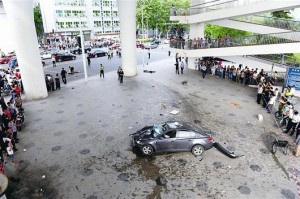
A photo of a crash in Hubei that killed 4 people after the driver of the car suffered an epileptic seizure.
Recently, a man in Hubei was sentenced to life in prison for causing the deaths of four people when he crashed into a group of pedestrians after suffering from an epileptic seizure. Most of the comments in response to the article have centered around how stupid it was of the man to keep his illness secret and keep driving. Of course, the man should not have been driving, but I thought it was important to have a discussion about why someone in China would feel the need to keep an illness like this secret. I thought it was best to have someone who knows what it like to have epilepsy and live in China talk about it. Ondreianna MacKenna, a member of Women Writers of Shenzhen, has agreed to share her story about living in China with epilepsy.
IMAGINE walking down the street when your thoughts suddenly become sluggish and thick like feet walking in a muddy creek bed. Then you realize you can’t feel much of your body and the edges of your vision are beginning to slide into a gray fog ever so slowly. You take a breath to calm yourself, but something else, something other than your own mind hijacks your thoughts and an icy panic runs up your spine while the world around you begins to tilt and turn like a twisted, tormenting theme park ride.
This is what the beginning of a seizure feels like, at least for some people. For me, this is normal. While I can’t say you ever quite get used to the confusion, the fear, the pain (both mental and physical) and the hijacking of both your mind and your body with varying levels of awareness, I can tell you that it is a struggle that I am well equipped to handle. I have lived with seizures all of my life and have seizures nearly every week (sometimes more often), even at 29.
There are many limitations to having epilepsy or other seizure disorders; however, the challenges and the limitations take a different turn when one moves to a foreign country. My husband and I have been living in China for two years now. China is a wonderfully vast country full of cultural idiosyncrasies, interesting foods, an old culture, a complicated people, amazingly beautiful lands, frustrations, joys, wonders and even mysteries. I love living here, but it is often a minefield rife with dangers for someone like me – someone with seizures.
Common Seizure Triggers
One of the most common triggers (things that cause seizures in those who have seizure disorders) is flashing lights. This is generally called photosensitive seizures, meaning you are sensitive to light and, in this case, to light patterns. So I have to be extremely cautious walking around popular squares or areas of cities at twilight and nighttime; because if there is one thing China likes it is anything that will get your attention. Rapidly changing and moving images on huge LED screens liter these common areas and cause me a plethora of issues. These can range from a severe headache to twitching/spasms to even a full seizure all dependent on how much light directly catches my eyes and the duration of exposure. Adding to these mines there are often string lights or runner lights that are flashing around doors or signs for shops, hotels, stores, restaurants, and other misc businesses that would like to have flashy neon adverts.
 Another trigger for me is crowds and lots of chaotic noises. I know, I know, most people ask me, “Then why in the world did you choose to move to China of all places?” Yes, it is true that China is often perceived as being the motherland of chaotic crowds and the cacophony of noise they release, but the simple answer is that it’s not like that everyday everywhere. I came from a small area with a low population, but even there I sometimes had to worry about crowds like in a busy restaurant, special sales at superstores, or even in day to day living at a busy university. You can’t escape crowds if you want to be a part of a society at large and not live on a farm in isolation.
Another trigger for me is crowds and lots of chaotic noises. I know, I know, most people ask me, “Then why in the world did you choose to move to China of all places?” Yes, it is true that China is often perceived as being the motherland of chaotic crowds and the cacophony of noise they release, but the simple answer is that it’s not like that everyday everywhere. I came from a small area with a low population, but even there I sometimes had to worry about crowds like in a busy restaurant, special sales at superstores, or even in day to day living at a busy university. You can’t escape crowds if you want to be a part of a society at large and not live on a farm in isolation.
So I adapted and developed a strong fighting spirit along with a keen sense of observation. With a world so full of dangers in the environment around you and inside you, at all times you must be sure of where the safe areas are, where the exits are, and possible aids (i.e. something to drink, dark places, quiet places) and learn a great deal of physical discipline. This is how I walk through China in my everyday life. I step around crowds or focus on counting my steps so my brain is occupied and, therefore, less able to take in bad stimuli if I have to go through crowds. I wear headphones a lot so that outside sound is muffled or my music drowns it out.
Epilepsy Stigmas in China
You might ask, “Could you ask for help?” The answer in America and other countries is a hesitant “yes,” I could, for the most part; however here in the East there is a rather strong stigma that pushes those with seizure disorders to be silenced. I learned very quickly through experience and reading other people’s stories online that I must keep this a secret or risk some fallout. The stigma can range from fear of it somehow being a contagion that could be inflicted on other people – which elicits fear and sometimes verbal violence – to being a symptom of some kind of darker psychological disorder hinting at possible dangers or violence everyone around.
 Other stigmas from less developed areas revolve around seizures being some kind of trick or punishment from an external source such as spirits, karma, or even bad luck. Thus, if you are being punished by some higher power, then you have done something to warrant this and should be given a wide berth.
Other stigmas from less developed areas revolve around seizures being some kind of trick or punishment from an external source such as spirits, karma, or even bad luck. Thus, if you are being punished by some higher power, then you have done something to warrant this and should be given a wide berth.
Madness, possession, contagious disease, cosmic punishment, psychologically disturbed, irreparable human, mistake, broken, reject, and subhuman are many of the labels thrust upon people with seizures in this society. They are often told they should never marry nor should they hold a job. In fact, if a person were diagnosed with epilepsy before marriage, the sufferer would be denied a marriage license. And of course, children are out of the question. Often people are fired if they have a seizure at work. The person or even family members are often shunned and ignored in their own neighborhoods. If the one suffering from seizures is a child, many other parents will not allow their children to play with “those children” for fear of some sort of damage or repercussion falling on their children.
I have been lucky enough to not have anything but minor seizures out in public or make it back to my apartment in time for a larger seizure. I have to be careful of not getting overheated or overly tired, and I have to be careful about the foods I eat too as some chemicals (MSG) and foods (pork for me) can worsen or even cause seizures.
I am truly blessed because I grew up with parents that were patient and loving even in the grips of a child suffering from a disorder they didn’t understand well. However, many children and even adults here in China do not have that same level of support. Orphanages here are filled with children who have various disabilities or disorders; they are thrown away for falling short of “perfect.”  Teenagers and adults are often sent away or kept in seclusion, denied even the basics of a proper education.
Teenagers and adults are often sent away or kept in seclusion, denied even the basics of a proper education.
Recently there was a man in Hubei who was sentenced to a life in prison after a seizure resulted in a fatal car crash while he was driving. Yes, he should NOT have been driving, that is undeniable, but he will never receive treatment, support, or good medicines in prison. This is an example of how China deals with “disruptive” disorders, they tend to put you somewhere and ignore you in hopes that the problem will go away.
The Future of Seizure Disorders in China
Now please don’t think that things are hopeless, because they are not. In the last eight years, China has made some remarkable strides in trying to get more information out there about seizure disorders for public consumption and to delineate disorders and disabilities. There are disability groups and agencies popping up all over China, and some colleges are now trying to aid students with special needs. I admit the progress is slow, but it is wonderful and heading in the right direction.
I would like to end this blog about living in China with epilepsy by explaining that while life for me is limited and often more difficult than some people, I have more freedom and independence here than I did back home. Things are more closely placed here and the public transits are remarkable. Back home, we had lots of land, so everything is so spread out that walking was not feasible. Public buses were unreliable and often not running, subways didn’t exist and taxis were too expensive, if you can even find one. In China, I am able to go anywhere I want, when I want, and how I want. For the first time in my 29 years of life, I am able to taste what being an independent adult tastes like and this is one of many reasons I feel freer here in China than in America despite hiding my “dirty little secret.”
 Ondreianna MacKenna has been living in China since 2013 and Shenzhen since 2014. She is working on getting her PhD in clinical psychology and is an aspiring author and blogger. You can visit her at her blog Surviving China where she is happy to answer any questions about epilepsy, seizures, or living with such conditions in China.
Ondreianna MacKenna has been living in China since 2013 and Shenzhen since 2014. She is working on getting her PhD in clinical psychology and is an aspiring author and blogger. You can visit her at her blog Surviving China where she is happy to answer any questions about epilepsy, seizures, or living with such conditions in China.
May 21, 2015
Zoe in America – First Stop: San Francisco!

Zoe’s first time on an airplane!
I had been excited for over 6 months about my trip to America since my godparents told me they were going to take me there for Chinese New Year, but from the very beginning, I barely knew anything about our plans. My mom decided this would be a surprise trip for me and she did a good job. So most days started like this: “Zoe, are you ready to go? Are you excited?” “Yes, yes, I am. But where are we going?”
My dad even messaged me before my trip to Shenzhen. He told me they had secret plans for San Francisco.
“Hey Zoe, do you know what are we gonna do in San Fran?”
“No, so what are we gonna do?
“Do you really wanna know? But you have to promise not to tell mom that I told you this.”
“No no no, don’t tell me, no spoilers!”
“Ok, I won’t tell you our hot air balloon trip…”
“Oh my god, you are so mean, but I love you.”
“because we are not going on one.”
“I …….”
So deep in my mind, I thought we were going on a hot air balloon trip. And I pretended I knew nothing about it.
The minute we got out of the airport and were waiting for a taxi, I looked at the sky, it was a beautiful afternoon, the sunset was like a fire in the sky, but not so strong as fire. Yes, it was like a giant exploding orange, and I saw so many birds, I was like a 5-year-old child, so excited and so surprised. And then I finally realized, “OH MY GOD, I AM IN AMERICA!”
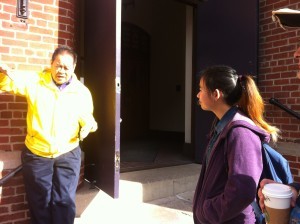
Tour Guide Dave explaining some Chinese-American history to Zoe.
Then we walked into Chinatown, I thought it was just happened on the way to the bridge. But then my mom said, “ here we go, Chinatown, that’s our trip for today!” I thought she was joking. “Haha, you are funny.”The next day, they took me out, of course I knew nothing about where were we going! I just kept guessing by looking at the building near us. San Francisco is so crowed, it was just like Hong Kong. So when I saw the Golden Gate Bridge, I was so sure we were going to the world known bridge. I shouted, “ yay, I saw the bridge!” but they pretended they didn’t know what I was talking about! So I am even more certain. Maybe we would take the hot air balloon on the bridge! But, we didn’t!
But then I noticed they were kinda serious, but we stopped moving!
“errr….what? really? Chinatown? But I am a Chinese myself!” but at the end of the trip, it was definitely a great place to visit!
I do know Chinese culture well enough, but I didn’t know anything about American Chinese culture! We had a tour guide, David. He is an American Chinese himself, but could not speak Chinese (most people in Chinatown speak Cantonese.). He showed us around Chinatown and told us a lot about the history. IT was all very surprising to me. I thought the first Chinese immigrants just came to America and then “la de dah , we were in America” and then lived happily ever after. But I was totally wrong. They first came here as railway labor workers. They didn’t have citizenship, they couldn’t get married, they couldn’t own property. So to speak, they didn’t have many human rights or much freedom. The buildings in Chinatown showed us how they managed to squeeze into such tiny spaces. They rebuilt everything after the great earthquake and great fires of 1908. Life was tough but they stayed. Looking at the buildings, I tried to imaging myself in that time, but I couldn’t, I could not image how they left mother China, stayed in America, worked in America and lived in America. But look nowadays, they finally got paid back. The first Chinese immigrants to American took China with them and kept it the way it was, so no matter how many years after, their children, grandchildren, great-grandchildren all know where they came from.
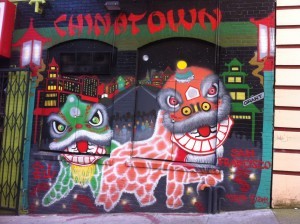
One of the many gorgeous murals around Chinatown.
What do the Chinese like the most? Food , money and gambling. You can really see that in Chinatown. There was an open area where many people just sat together and gambled. People in Chinatown also kept some Chinese traditions that we don’t follow in mainland China. As a young person, I don’t have much experience with traditional China. The most traditional Chinese thing we do is Chinese New Year, but the most memorable thing about Chinese New Year for kids in the lucky money they get in their hongbao. It’s just a big break from work for many people, and the tradition part is gone.
Zoe Gong was born in rural Hunan in 1995 and is fluent in English. She has worked in English training centers and at expat restaurants since she was 16. She is currently a tourism management major at Changsha University in Hunan.
May 17, 2015
Give the Dog a Bone – Let Guide Dogs in China Help the Visually Impaired!
The following was originally published by the Shenzhen Daily .
Last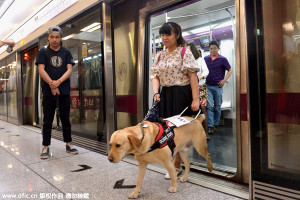 week, when Beijing announced that seeing eye dogs would be allowed on the Beijing metro, my first thought wasn’t “wow, this is a great move on Beijing’s part.” Instead, my first thought was “seeing eye dogs weren’t already allowed on Beijing subways?” followed by “seeing eye dogs aren’t already allowed on all of China’s subways?”
week, when Beijing announced that seeing eye dogs would be allowed on the Beijing metro, my first thought wasn’t “wow, this is a great move on Beijing’s part.” Instead, my first thought was “seeing eye dogs weren’t already allowed on Beijing subways?” followed by “seeing eye dogs aren’t already allowed on all of China’s subways?”
While allowing seeing eye dogs on Beijing subways is a great thing, it is shameful that such a reasonable accommodation for the blind is only just now being made. Allowing seeing eye dogs to accompany their owners everywhere they go seems like a common-sense regulation that could be enacted with the sweep of a pen.
China has a huge problem with accessibility services. My husband and I are in the process of adopting a child here in China. We have considered adopting a child with disabilities, but the lack of accessibility services is worrisome. The last apartment building we lived in was beautiful and in a great community, but we lived on the fourth floor with no elevator, which would make life very difficult for a child with disabilities.
In fact, there are problems for the disabled everywhere in this city.
There are many buildings in China, even government buildings, schools, train and bus stations, that are completely inaccessible to people with disabilities. Shenzhen Daily has published many heartbreaking stories about children who have had to drop out of school because their classrooms are inaccessible.
 Many of Shenzhen’s subway stations don’t have enough elevators and escalators and some streets are difficult for a wheelchair to cross.
Many of Shenzhen’s subway stations don’t have enough elevators and escalators and some streets are difficult for a wheelchair to cross.
Many of China’s sidewalks also pose dangers for the disabled since they are often uneven or blocked by cars and street vendors.
Even when taking the ferry from Shenzhen to Hong Kong, it would be impossible for many disabled people to enter Hong Kong because the immigration check is upstairs and there is no elevator in the building.
I realize that fixing these problems will take time. After all, new escalators, elevators, and ramps all require money, but allowing seeing eye dogs to accompany their owners wherever the owner goes wouldn’t require any money or infrastructure, it would require a simple change of the law.
Seeing eye dogs have been used for hundreds of years.
The dogs do much more than simply help their owners navigate outside the safety and familiarity of their homes. Seeing eye dogs protect their owners from danger and guide them through the hazards of a city.
The dogs provide their owners with confidence, companionship and security. The dogs also reduce stress for their owners, which leads to a better quality of life.
Seeing eye dogs are not merely pets, they are tools that many blind people need to survive.
According to the China Association of the Blind, there are over 17 million people in China who are visually impaired. But according to the China Guide Dog Training Center, China’s only training institution for guide dogs, only 67 dogs had graduated from their program as of February 2014 while another 54 dogs were in training and a group of 35 puppies were being prepared for training. In the U.S., there are currently 13 organizations that provide hundreds of guide dogs absolutely free for visually impaired persons every year.
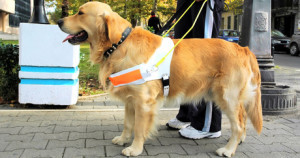 One of the reasons seeing eye dogs are not popular in China — despite the obvious need — is that owners are not allowed to bring the dogs with them to many places they need to go.
One of the reasons seeing eye dogs are not popular in China — despite the obvious need — is that owners are not allowed to bring the dogs with them to many places they need to go.
Why would a person with a visual impairment have a dog if he or she can’t take the dog on the subway, on a bus, into a grocery store or to the bank?
The whole purpose of a seeing eye dog is to protect its owner when navigating the world. Restrictions on seeing eye dogs nullify their benefits.
The very least the Chinese Government could do for the blind in China is pass a nationwide law allowing seeing eye dogs to accompany their owners wherever they go.
This isn’t something that needs to happen slowly over time — this problem could be rectified today.
Throw seeing eye dogs a bone and let them help their owners!
April 27, 2015
Shenzhen Man Spends 30 Years Raping Mentally Ill Woman, Hailed as “Responsible”
 Over 30 years ago, a young woman named Adi in her early 20s was in a tragic accident that left her with the mind of an infant. Even though she had the body of an adult, she couldn’t care for herself or even express herself to those around her.
Over 30 years ago, a young woman named Adi in her early 20s was in a tragic accident that left her with the mind of an infant. Even though she had the body of an adult, she couldn’t care for herself or even express herself to those around her.
One day, a barefoot doctor came to her village. This man had minimal medical training, but because doctors were so rare in the Chinese countryside, the villagers accepted his help. This man claimed he could help heal Adi. Her parents trusted him. Over time, the man began to claim that he was in love with Adi, a woman who could neither accept or reject his advances. Without even a basic understanding of what was happening to her, her parents consented to the wandering doctor’s marriage proposal. The man then began having regular intercourse with Adi, forcing her to have many children.
Adi, unable to communicate, did what she could to end her suffering, throwing herself into a lake near her house. But she was always pulled back, always forced back into the bed of her rapist.
 For 30 years, Adi has been called the wife of her rapist. All the while, this putrid excuse for a human being forces Adi to act against her will. Since Adi cannot protest, some in the community believe that what the doctor is doing is a great thing, taking care of a mentally handicapped woman for over three decades. ““He is truly a responsible man. He took care of his wife for all these 30 years,” says one of the villagers. Yet no one but Adi knows the horrors she faces everyday, the pain she feels deep inside that she cannot express.
For 30 years, Adi has been called the wife of her rapist. All the while, this putrid excuse for a human being forces Adi to act against her will. Since Adi cannot protest, some in the community believe that what the doctor is doing is a great thing, taking care of a mentally handicapped woman for over three decades. ““He is truly a responsible man. He took care of his wife for all these 30 years,” says one of the villagers. Yet no one but Adi knows the horrors she faces everyday, the pain she feels deep inside that she cannot express.
While this may sound like a horror story, it is actually true. The story of Adi’s rapist, a man who goes by the surname of Zeng, was recently told in the Shenzhen Daily. Of course, since Adi cannot speak for herself, the story was reported from his point of view. However, Adi’s story comes through clearly. A woman who does not have the mental capability to consent to marriage or sex was forced into both, and her attacker is viewed as a hero for spending his life taking care of her. The truth is that Zeng is a disgusting, abusive monster who needs to be in prison. Even though Adi is finally getting the help she needs for her mental condition, there are no efforts being made to remove her from the home of her rapist.
This is why China needs feminism, so that people can learn what consent means.
April 14, 2015
Will Disney Whitewash Mulan?
The Internet erupted in cheers after the announcement that Disney is going to start production on a live-action version of Mulan. After the roaring success of Cinderella, Disney has a whole slate of films planned that will turn their beloved children’s cartoons into live-action versions, including Beauty and the Beast, Dumbo, and The Jungle Book.
 Mulan is Awesome
Mulan is AwesomeMulan is one of my favorite Disney films. Of course, that is largely because the film is set in China, but also because Mulan is one of the Disney heroines that kicks lots of ass in more ways than one. While the film does open on her visiting a matchmaker and there is a love sub-plot, love and marriage are minor aspects to the story. Its one of the few Disney cartoons that focuses on a female character with a completely different driving force. Frozen received far more acclaim for being “feminist” than it was or deserved while Mulan is routinely left out of arguments about whether Disney women are good role models for young women.
A pattern of whitewashing
 As one of the few Disney women of color, there is already a lot of pressure on Disney to get the casting right. A petition is already circulating demanding that Disney not cast a white actress as Mulan. It might seem obvious that Disney would cast a Chinese woman to play Mulan, but Hollywood has a poor reputation when it comes to representing people of color in film. Aside from the huge lack of people of color in film (only 4% of female characters in American films last year were Asian or Latina), characters that should be people of color often are not. One of the biggest miscasts of the year was Rooney Mara as Tiger Lily in the new Peter Pan remake (which looks like a rather crappy movie overall). There was also the hugely disappointing casting of Matt Nable as Ra’s al Ghul on the CW’s Arrow. Unfortunately, Ra’s al Ghul and The Mandarin (both notable comic book villains of color) have never been played by man of color on TV or in film. Perhaps the most egregious recent case of whitewashing in Hollywood would have to be Ridley Scott’s Exodus: Gods and Kings. This image pretty much sums that catastrophe up.
As one of the few Disney women of color, there is already a lot of pressure on Disney to get the casting right. A petition is already circulating demanding that Disney not cast a white actress as Mulan. It might seem obvious that Disney would cast a Chinese woman to play Mulan, but Hollywood has a poor reputation when it comes to representing people of color in film. Aside from the huge lack of people of color in film (only 4% of female characters in American films last year were Asian or Latina), characters that should be people of color often are not. One of the biggest miscasts of the year was Rooney Mara as Tiger Lily in the new Peter Pan remake (which looks like a rather crappy movie overall). There was also the hugely disappointing casting of Matt Nable as Ra’s al Ghul on the CW’s Arrow. Unfortunately, Ra’s al Ghul and The Mandarin (both notable comic book villains of color) have never been played by man of color on TV or in film. Perhaps the most egregious recent case of whitewashing in Hollywood would have to be Ridley Scott’s Exodus: Gods and Kings. This image pretty much sums that catastrophe up.
Same Difference
 So there is good reason for people to be concerned about Mulan’s casting. In fact, Mulan already has a live-action counterpart on television, on ABC’s Once Upon a Time. However, she isn’t played by a Chinese actress, but a Korean one, Jamie Chung. My problem with this casting is that is perpetuates the belief that all Asians are the same, as if they are interchangeable.
So there is good reason for people to be concerned about Mulan’s casting. In fact, Mulan already has a live-action counterpart on television, on ABC’s Once Upon a Time. However, she isn’t played by a Chinese actress, but a Korean one, Jamie Chung. My problem with this casting is that is perpetuates the belief that all Asians are the same, as if they are interchangeable.
I remember when Memoirs of a Geisha came out several years ago and there were many complaints from the Japanese and Chinese communities that the three main roles in the film went to Chinese actresses. I didn’t really understand the outrage at the time, but after living in China for so long, I certainly now see the casting was inappropriate. Casting a few minor characters as Chinese would have been alright, sort of how George Takei did a voice of a Chinese ancestor in the cartoon version of Mulan, but for the face of Memoirs of a Geisha to be Chinese was offensive.
Dolla-dolla-bills
 So will Disney whitewash Mulan? I don’t think so. Disney is first and foremost and always a business. Their bottom line is always going to guide their decisions. While most of Disney’s films are marketed in America and geared for the American market, Mulan is an exception because it can (and will) be marketed heavily to the Chinese market, and that is a market that matters.
So will Disney whitewash Mulan? I don’t think so. Disney is first and foremost and always a business. Their bottom line is always going to guide their decisions. While most of Disney’s films are marketed in America and geared for the American market, Mulan is an exception because it can (and will) be marketed heavily to the Chinese market, and that is a market that matters.
Last year, the movie that made the most money in the world was one of the worst movies of the year (and probably all time), Transformers 4. The reason for that is because it made over US$300 million in China alone, the largest-grossing film in China of all time. The movie was heavily marketed here, filmed here, and gave minor roles to several notable Chinese actors. Two other big recent movies were Iron Man III and X-Men: Days of Future Past – both of which included token parts for China’s biggest actress, Fan Bingbing. Hollywood is slowly but deliberately pivoting decisions about their filmmaking with the China market in mind.
China is the second-largest film market in the world, just trailing the U.S. Disney might not cast a Chinese woman as Mulan because that is how it should be, but they will because they know it will catch them millions of those sweet, sweet RMBs.
So what do you think? Am I wrong? Will Disney cast a white Mulan? Let me know what you think in the comments.
April 8, 2015
Step 1 of probably 100 million
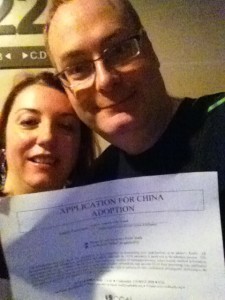 As any reader of this blog or anyone who has ever met us knows, our dream is to adopt a baby here in China. We finally took that first step and submitted our initial application, which was approved last week! Yay!
As any reader of this blog or anyone who has ever met us knows, our dream is to adopt a baby here in China. We finally took that first step and submitted our initial application, which was approved last week! Yay!
That was probably the easiest step, though. I was immediately given about 50 more forms to fill out before we can start our home study, which is a whole other thing. But we are just taking it one step at a time.
Adoption, especially international adoption, is an expensive way to grow a family. And we have additional hurdles and costs to face because we live abroad. We have set up two crowdfunding campaigns, one at IndieGogo and one at GoFundMe (because I know different people prefer different platforms). I am offering copies of Crazy Dumplings (digital copies and physical copies) and the amazing crazy dumpling dumplinger as Thank You gifts for supporters, so if you missed out on our Kickstarter campaign or want more books or dumplingers as gifts, this is your chance!
Also, adoption is a very personal journey. I am a pretty open person, and I am looking forward to sharing our journey with readers, but I have already been struggling with how much to share with readers. How can I tell my story without overstepping the boundaries of what is our child’s story and her right to keep her story private or share when she is ready? As a writer, this is something I will probably always struggle with as my kids grow. But in light of that, there are some things about the adoption journey I won’t be sharing publicly on the blog, but might be more willing to share with our supporters, people who I know care about us, our child, and our story. So I will be setting up a separate mailing list just for supporters to get more “behind the scenes” information about our journey.
So anyway, that is what we are up to right now. The adoption is really our main focus right now. If you want to help, please share our campaigns on your social media accounts and help us get the word out!
April 5, 2015
Care for comfort women begins at home
The following was originally published in The Shenzhen Daily. It is republished here in full with links to sources added.
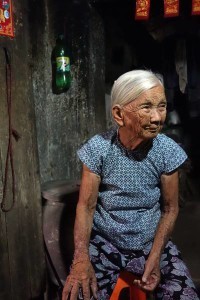
Former comfort woman Wang ZhiFeng
HARDLY a week goes by that the Chinese Government does not criticize the Japanese Government for refusing to acknowledge and apologize for its crimes in China during World War II. Since 2015 marks the 70th anniversary of the end of the 2nd Sino-Japanese War, the outcry against Japan and calls to remember the Rape of Nanjing have been constant.
One of the most controversial aspects of this issue is that of comfort women, a placid euphemism for the brutal kidnapping and rape of hundreds of thousands of women throughout Asia by Japanese soldiers during the war. Even though as many as 400,000 women suffered as sex slaves during the war, some of Japan’s top officials have gone so far as to deny the women even existed.
The suffering of the comfort women did not end with the war. The terrible facts of life after the war are described in detail in Peipei Qiu’s new book “Chinese Comfort Women.” Many comfort women hid their past as best they could because they were treated so shamefully by Chinese society. Today, only 23 comfort women are officially counted in China, but there could be many more who kept silent about their past after seeing their fellow comfort women persecuted again and again. Many of them then suffered humiliation and indignities at the hands of their own countrymen during the Cultural Revolution. Their property was confiscated, their families punished, and they were publicly “struggled” against as “Japanese collaborators.”
 Even today, the few known comfort women do not receive any support from the Central Government, though a few receive a paltry sum of 100 yuan a month as part of local social security schemes. A report in China Daily describes the living conditions of the women today as “desperate.” The newspaper quoted Su Zhiliang, director of the Research Center at Shanghai Normal University, as saying, “Most of the former comfort women still alive in China live in desperate conditions — physically, socially, and financially — and they long for attention, recognition, and support from society.”
Even today, the few known comfort women do not receive any support from the Central Government, though a few receive a paltry sum of 100 yuan a month as part of local social security schemes. A report in China Daily describes the living conditions of the women today as “desperate.” The newspaper quoted Su Zhiliang, director of the Research Center at Shanghai Normal University, as saying, “Most of the former comfort women still alive in China live in desperate conditions — physically, socially, and financially — and they long for attention, recognition, and support from society.”
Caring for comfort women needs to begin at home. According to some statistics, at least 40 percent of former comfort women never married because they were ostracized by society. This leaves them without descendants to care for them today. Most of the women suffered from devastating health consequences — infertility, chronic pain, etc. — that can cost thousands of yuan per month in medical bills. Some of the comfort women are being cared for by NGOs and individuals. The NGOs and individuals are collecting their stories, donating money and providing funerals for those who pass away. Why isn’t the government taking the lead in these efforts?
In South Korea, another country whose women were abused by the Japanese troops, their comfort women are well taken care of. They live in special nursing homes and have all their medical and physical needs cared for by the government. Li Xiaofang is a photographer and historical researcher who has been recording the lives of the surviving comfort women for more than a decade. He told China Daily, “There are more former comfort women here in China than in South Korea, and their experiences were equally miserable… they deserve more attention and support.”
While the Japanese should apologize and pay for their war crimes, the women they brutalized are not Japanese, they are Chinese. It is the responsibility of the Chinese Government to care for these aging testaments to history. Waiting for the Japanese to step in and take responsibility for the comfort women is a waste of time and precious lives. The Chinese Government can act now and take the lead in showing the world how these women should be honored.







